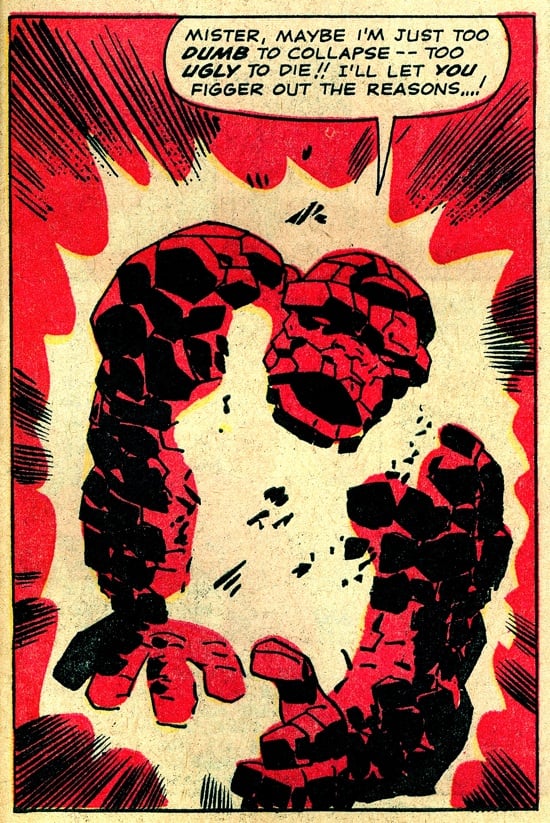Too Ugly to Die!!
By:
April 9, 2011

This panel, from Fantastic Four #40 (July 1965), is really the essence, the whole point of superhero comics, isn’t it?
[HiLobrow recently published a series of 25 posts, by 25 authors, each analyzing a single panel from a Jack Kirby-drawn comic book. This essay by Danny Fingeroth is the fifth of five Kirby exegetical commentaries added to the series.]
Every hero, especially a Marvel hero, has a moment like this in their career. The moment when they beat the odds not through power or skill or courage or even luck, but through the sheer refusal to give up.
And this is the most unique Marvel hero: the Thing. The hero who is a monster. (Or the monster who is a hero.) A couple of pages earlier, he’d been in his handsome human incarnation of Ben Grimm. But to stop Dr. Doom, Reed Richards had turned Ben — against his will, or at least without his consent — back into the super-strong, orange-rocked aberration.
Grimm was angry over it — though, hero that he is, he probably would have volunteered, given the chance — and now he’s going to stop Doom from hurting him and his friends, from menacing New York. Ben’s rage, resentment and regret are all there in Kirby’s art, and are heightened to the ultimate level by Stan Lee’s dialogue.
Ben Grimm is far from “dumb.” He has great native intelligence, street smarts, combat experience, a university degree, and training as a test pilot and astronaut. Still, it’s to the Thing’s advantage to have opponents think him stupid and thereby underestimate him — hence his constant colloquial, Ed Norton-style wisecracking. As Ben, the character is ruggedly handsome, far from “ugly.” As the Thing, despite his grotesque appearance, he nonetheless has the love of the beautiful and creative — albeit blind — Alicia Masters, and the sincere friendship of his teammates and many others. But no one wants their better qualities to have to be explained, to have an asterisk, as it were. So the self-deprecating statements he makes in this panel are no doubt how the Thing often does feel about himself.
If you know the shared past and longtime enmity between Doom and Grimm, the scene is all the more poignant. But all you need to know here is in the couple of pages preceding this panel. Ben had been relieved of the burden and punishment of being the Thing. What he lost in power he had regained in normalcy. Now, thanks to a necessary betrayal by his best friend — a betrayal that would become the catalyst for the next story arc — he has had that burden and punishment restored. His rage is enormous and his emotional agony so great it enables him to ignore the physical pain of Doom’s “nerve-shattering energy blasts” (so described in the previous panel) and do what has to be done. Kirby’s explosive drawing conveys this with brutal elegance.
As much as any character, the Thing seamlessly combined the talents of Lee and Kirby. While the character is often seen as the comics avatar of Kirby (who, a decade later, would write and draw a “What If” story in which he did indeed become the Thing), with Lee more often identified with Spider-Man and the Silver Surfer, a reader can’t help but feel that Lee, too, regularly expressed his feelings about life through the Thing. Certainly in this panel, Lee’s verbal alacrity and dramatically paced phrasing are evident in the rocky horror’s direct yet literary dialogue. As in a Lennon/McCartney song or a Coen brothers movie, the two creators function as a single entity and provide this one-panel definition of the Thing — and, indeed, of the entire superhero genre at its best.
CHECK OUT “Cosmic Debris: Kirby in the ’70s,” a series that ran in tandem with “Kirb Your Enthusiasm” at the 4CP gallery of comic book details | Kirby cutaways and diagrams collected at the Comic Book Cartography gallery | Joe Alterio’s Cablegate Comix and HiLobrow posts about comics and cartoonists, and science fiction | The Jack Kirby Chronology | scans of rare 1940-50s Kirby comics at the Digital Comic Museum
KIRB YOUR ENTHUSIASM: Douglas Rushkoff on THE ETERNALS | John Hilgart on BLACK MAGIC | Gary Panter on DEMON | Dan Nadel on OMAC | Deb Chachra on CAPTAIN AMERICA | Mark Frauenfelder on KAMANDI | Jason Grote on MACHINE MAN | Ben Greenman on SANDMAN | Annie Nocenti on THE X-MEN | Greg Rowland on THE FANTASTIC FOUR | Joshua Glenn on TALES TO ASTONISH | Lynn Peril on YOUNG LOVE | Jim Shepard on STRANGE TALES | David Smay on MISTER MIRACLE | Joe Alterio on BLACK PANTHER | Sean Howe on THOR | Mark Newgarden on JIMMY OLSEN | Dean Haspiel on DEVIL DINOSAUR | Matthew Specktor on THE AVENGERS | Terese Svoboda on TALES OF SUSPENSE | Matthew Wells on THE NEW GODS | Toni Schlesinger on REAL CLUE | Josh Kramer on THE FOREVER PEOPLE | Glen David Gold on JOURNEY INTO MYSTERY | Douglas Wolk on 2001: A SPACE ODYSSEY | MORE EXEGETICAL COMMENTARIES: Joshua Glenn on Kirby’s Radium Age Sci-Fi Influences | Chris Lanier on Kirby vs. Kubrick | Scott Edelman recalls when the FF walked among us | Adam McGovern is haunted by a panel from THE NEW GODS | Matt Seneca studies the sensuality of Kirby’s women | Btoom! Rob Steibel settles the Jack Kirby vs. Stan Lee question | Galactus Lives! Rob Steibel analyzes a single Kirby panel in six posts | Danny Fingeroth figgers out The Thing | Adam McGovern on four decades (so far) of Kirby’s “Fourth World” mythos | Jack Kirby: Anti-Fascist Pipe Smoker | BTOOM! Kirby vs. Lee, by Rob Steibel
SIMILAR HILOBROW SERIES: SECRET PANEL —Silver Age comics’ double entendres | SKRULLICISM
